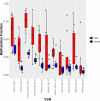Genome wide exploration of the methylome in aggressive B-cell lymphoma in Golden Retrievers reveals a conserved hypermethylome
- PMID: 35912844
- PMCID: PMC9665123
- DOI: 10.1080/15592294.2022.2105033
Genome wide exploration of the methylome in aggressive B-cell lymphoma in Golden Retrievers reveals a conserved hypermethylome
Abstract
Few recurrent DNA mutations are seen in aggressive canine B cell lymphomas (cBCL), suggesting other frequent drivers. The methylated island recovery assay (MIRA-seq) or methylated CpG-binding domain sequencing (MBD-seq) was used to define the genome-wide methylation profiles in aggressive cBCL in Golden Retrievers to determine if cBCL can be better defined by epigenetic changes than by DNA mutations. DNA hypermethylation patterns were relatively homogenous within cBCL samples in Golden Retrievers, in different breeds and in geographical regions. Aberrant hypermethylation is thus suspected to be a central and early event in cBCL lymphomagenesis. Distinct subgroups within cBCL in Golden Retrievers were not identified with DNA methylation profiles. In comparison, the methylome profile of human DLBCL (hDLBCL) is relatively heterogeneous. Only moderate similarity between hDLBCL and cBCL was seen and cBCL likely cannot be accurately classified into the subtypes seen in hDLBCL. Genes with hypermethylated regions in the promoter-TSS-first exon of cBCL compared to normal B cells often also had additional hyper- and hypomethylated regions distributed throughout the gene suggesting non-randomized repeat targeting of key genes by epigenetic mechanisms. The prevalence of hypermethylation in transcription factor families in aggressive cBCL may represent a fundamental step in lymphomagenesis.
Keywords: BCL; DLBCL; Golden Retriever; MIRA; cancer; canine; lymphoma; methylome; sequencing.
Conflict of interest statement
No potential conflict of interest was reported by the author(s).
Figures



Similar articles
-
Gene profiling of canine B-cell lymphoma reveals germinal center and postgerminal center subtypes with different survival times, modeling human DLBCL.Cancer Res. 2013 Aug 15;73(16):5029-39. doi: 10.1158/0008-5472.CAN-12-3546. Epub 2013 Jun 19. Cancer Res. 2013. PMID: 23783577 Free PMC article.
-
Genome-wide DNA methylation analysis using MethylCap-seq in canine high-grade B-cell lymphoma.J Leukoc Biol. 2021 Jun;109(6):1089-1103. doi: 10.1002/JLB.2A0820-673R. Epub 2020 Oct 8. J Leukoc Biol. 2021. PMID: 33031589
-
DNA methylation profiling reveals common signatures of tumorigenesis and defines epigenetic prognostic subtypes of canine Diffuse Large B-cell Lymphoma.Sci Rep. 2017 Sep 14;7(1):11591. doi: 10.1038/s41598-017-11724-w. Sci Rep. 2017. PMID: 28912427 Free PMC article.
-
Uncovering the DNA methylome in chronic lymphocytic leukemia.Epigenetics. 2013 Feb;8(2):138-48. doi: 10.4161/epi.23439. Epub 2013 Jan 15. Epigenetics. 2013. PMID: 23321535 Free PMC article. Review.
-
The many layers of epigenetic dysfunction in B-cell lymphomas.Curr Opin Hematol. 2016 Jul;23(4):377-84. doi: 10.1097/MOH.0000000000000249. Curr Opin Hematol. 2016. PMID: 27055146 Review.
Cited by
-
Epigenetic Alterations in Canine Malignant Lymphoma: Future and Clinical Outcomes.Animals (Basel). 2023 Jan 29;13(3):468. doi: 10.3390/ani13030468. Animals (Basel). 2023. PMID: 36766357 Free PMC article. Review.
References
-
- Bushell KR, Kim Y, Chan FC, et al. Genetic inactivation of TRAF3 in canine and human B-cell lymphoma. Blood. 2015;125(6):999–1005. - PubMed
Publication types
MeSH terms
LinkOut - more resources
Full Text Sources
Other Literature Sources
